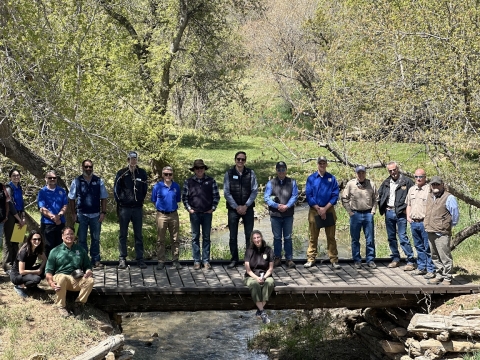On May 10, 2024, Martha Williams, Director of the U.S. Fish and Wildlife Service (USFWS), Matt Hogan, USFWS Mountain-Prairie Regional Director, and various USFWS field staff convened several trusted partners at the Cherry Creek Project Site in La Plata County, Col. Here, they announced over $700,000 in Bipartisan Infrastructure Law funding to renovate the site from a standard culvert that blocks the migration and movement of native fish in Colorado’s State Wildlife Action Plan to a box culvert that will allow all native species of fish, no matter their age to pass.
The box culvert will benefit not only Colorado’s aquatic native species that are critical to the Cherry Creek ecosystem but also the communities surrounding the site through investments in infrastructure for their county road, preventing erosion, and ensuring their taxpayer dollars are utilized on other necessary programs, services, or infrastructure. This announcement is part of the $70 Million for Fish Passage Projects to Address Climate Resilience and Strengthen Local Economies, which was recently announced on April 23, 2024. Furthermore, this investment builds on the Service’s 2022 and 2023 Bipartisan Infrastructure Law National Fish Passage Program investments of nearly $73 million in funding for 79 projects spanning the U.S.
To celebrate this announcement, representatives from partner organizations joined us during this site visit. The primary partner on this project, Colorado Parks and Wildlife (CPW), arrived with CPW Director Jeff Davis, communications specialists, fish biologists, and regional leadership. Further partner organizations, including Trout Unlimited, the Southern Ute Indian Tribe, the Nature Conservancy, and the La Plata County Commissioners Office, created the impressive team of wildlife and public service professionals that made this project happen. CPW Aquatic Biologist Jim White spoke to the impact of this project and the power of strong partnerships, stating, “This project will have a great benefit to the overall native fish community. By connecting approximately 20 miles of important habitats for native fish species, this will nearly double the available habitat in Cherry Creek. We cannot thank all of the partners involved in this project enough.” Together, the partners celebrated the positive impacts the project would have on native fish populations, aquatic genetic diversity, and the increased habitat range that will be made available to these species upon completion of the project. Following live capture, staff were also able to hold and learn more about the biology of the three species of fish that this project will impact: the Flannelmouth Sucker, the Roundtail Chub, and the Bluehead Sucker.
This is the first National Fish Passage Program funded by the Bipartisan Infrastructure Law Bipartisan Infrastructure Law
The Bipartisan Infrastructure Law (BIL) is a once-in-a-generation investment in the nation’s infrastructure and economic competitiveness. We were directly appropriated $455 million over five years in BIL funds for programs related to the President’s America the Beautiful initiative.
Learn more about Bipartisan Infrastructure Law in the state of Colorado. Learn more about other BIL-funded projects in the state of Colorado and across the entire United States here: Bipartisan Infrastructure Law 2023 Annual Report | FWS.gov. These funds and the completion of this project will make lasting impacts on not only this tributary but the entire watershed. Fish biologist USFWS Cole Britain stated, "Cherry Creek, a headwater tributary to the Colorado River, is a stronghold for native species. These native species, in particular, have seen their populations decline throughout the Colorado River System due to habitat fragmentation and introduction of non-native species. This project greatly benefits these native fish populations in two main ways. It makes the Cherry Creek populations much more resilient by reducing fragmentation of their habitat, and it helps the entire Colorado River System as these populations reproduce/grow and re-colonize areas downstream into the Colorado River.”
Please follow the links below to read our media partners stories on this site visit!
Disclaimer: Interior websites contain external links that do not imply endorsements.
Durango Herald: Federal, state officials laud funding for fish passage in La Plata County
Southern Ute Drum: Wildlife agencies dedicate Cherry Creek Fish Passage





